Ants in Seattle: Behavior, Types, and Control Methods
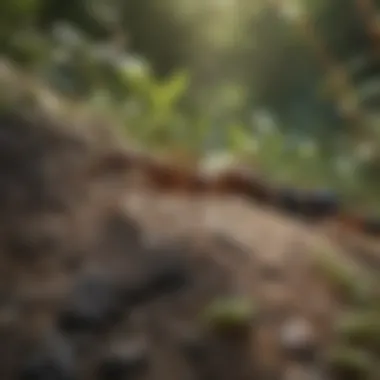

Intro
Ants are a common sight in Seattle, often traversing sidewalks, gardens, and even kitchens. As unsightly as they may be, understanding their behavior and types can help in managing their presence effectively. Seattle's unique environment supports various ant species that can wreak havoc if left unchecked. This article aims to equip homeowners with insights on identifying, preventing, and controlling ant infestations.
Pest Identification
Detailed Descriptions of Common Pests
In Seattle, several ant species are prevalent. Among them, the Carpenter Ant, Pavement Ant, and Odorous House Ant stand out.
- Carpenter Ant: These are large, ranging from 1/4 to 1/2 inch long, often black or bicolored. They are notorious for excavating wood, which can lead to severe structural damage in homes.
- Pavement Ant: Smaller, usually about 1/8 inch, and commonly found under stones and sidewalks. They have a smooth, dark brown or black appearance.
- Odorous House Ant: This species is about 1/8 inch long, and as their name suggests, they emit a peculiar smell when crushed, somewhat reminiscent of rotten coconut.
Signs and Symptoms of Infestations
Detecting an ant infestation early can save homeowners a lot of trouble. Here are some common signs to watch for:
- Trails of Ants: Look for pheromone trails leading to food sources.
- Nesting Areas: Check for nests around the house, typically in dark, damp places.
- Wood Damage: For carpenter ants, visible holes in wood with frass (sawdust) may signal a problem.
"Ants may just seem like a harmless nuisance, but when they start setting up shop in your home, they can quickly become a costly headache."
Prevention Strategies
Home Maintenance Tips for Pest Prevention
Keeping ants at bay requires vigilance and proactive measures. Consider these strategies:
- Seal Entry Points: Inspect windows and doors for gaps and use caulk to seal them. Small openings can be highways for ants.
- Cleanliness is Key: Regularly clean kitchen surfaces and vacuum to remove crumbs, especially after meals.
- Proper Food Storage: Store food in airtight containers to deny ants easy access.
Natural Deterrents and Barriers
Many homeowners prefer natural solutions for pest control. Here are effective options:
- Vinegar Solution: A 50/50 mix of vinegar and water can disrupt ant trails and eliminate scents they follow.
- Essential Oils: Peppermint and tea tree oils are known to repel ants. Mix with water and spray around entry points.
- Diatomaceous Earth: Sprinkle food-grade diatomaceous earth around entry points. It’s non-toxic and effectively dehydrates ants.
Treatment Options
Overview of Chemical vs. Natural Treatments
When it comes to dealing with ants, homeowners have two main avenues to explore: chemical treatments and natural solutions.
- Chemical Treatments: Typically, these include commercial insecticides specifically formulated for ants. They work quickly but may pose risks to pets and children if not used cautiously.
- Natural Treatments: Options like boric acid or baking soda mixed with sugar can attract and kill ants, offering a less toxic alternative.
Step-by-Step Guides for DIY Treatments
For those inclined to tackle the problem on their own, here are some simple DIY treatment steps:
- Boric Acid Bait: Mix equal parts of sugar and water with a tablespoon of boric acid. Soak cotton balls in the mixture and place them where ants are seen.
- Soap and Water Spray: Combine soap with water in a spray bottle. This concoction can kill ants on contact and help disrupt their pheromone trails.
- Plant Barriers: Consider planting mint or basil around the house. These plants not only add beauty but also deter ants with their scent.
By arming yourself with knowledge on ant species, signs of infestation, and effective prevention and treatment options, you can turn the tide in favor of your home while keeping it a comfortable haven.
Preamble to Ants in Seattle
Ants are more than just tiny creatures scurrying across sidewalks and lawns; they play essential roles in our ecosystems, influencing everything from soil health to the food web. In Seattle, the presence of various ant species presents unique challenges and considerations for both homeowners and pest control experts. Understanding these multifaceted insects is crucial, not just for dealing with infestations but also for recognizing the ecological benefits they provide.
Importance of Understanding Ant Behavior and Ecology
Seattle’s landscape, shaped by its wet climate and urban development, creates an environment where ants thrive. They are often seen as nuisances, particularly when they invade homes or gardens in search of food. However, not every ant is a menace. Many are actually helpful to our ecosystem, aiding in soil aeration and organic matter decomposition. By understanding their behavior, property owners can distinguish between harmful and beneficial species, allowing for the appropriate control methods to be used. It’s like differentiating between a well-meaning neighbor and a trespassing intruder.
Benefits of Gaining Insight into Ant Species
- Informed Control Choices: Knowing what type of ant you are dealing with allows for targeted approaches, minimizing unnecessary use of chemicals that may harm other beneficial wildlife.
- Eco-Balanced Solutions: By understanding their ecological role, homeowners can utilize natural control methods that often involve their natural predators.
- Avoiding Damage: Recognition of carpenter ants early on can save homeowners from severe structural damage to wooden elements in their properties.
Considerations for Homeowners
A proactive attitude towards managing ants can be pivotal. Homeowners who stay informed about ant behavior can implement preventative measures to deter invasions. For example, sealing cracks and keeping outdoor areas tidy can significantly reduce the lure of food and nesting sites. Yet, if an infestation occurs, recognizing the signs early can lead to smoother and more effective eradication efforts.
"Ants demonstrate the balance of nature; they can be both delightful and destructive, depending on how we choose to manage them."
In summary, comprehending the characteristics, types, and behaviors of ants residing in Seattle paves the way for effective management strategies. This section lays the groundwork for deeper exploration into the specific species that inhabit the region, their impacts, and the most effective control methods—helping homeowners keep their spaces clean and safe.
The Ecological Role of Ants
Ants are often overlooked in discussions about urban ecosystems, yet they play an essential role in maintaining ecological balance. Their activities contribute significantly to soil health, nutrient cycling, and even pest control. Recognizing these aspects is key for homeowners as they navigate ant sightings and potential infestations. Understanding how ants fit into the larger picture of the environment can illuminate why they are more than just pests, reshaping how people perceive these tiny creatures.
Ants as Ecosystem Engineers
Ants can truly be regarded as ecosystem engineers. This means that their presence and behaviors can substantially alter their environment, for better or worse. For example, the burrowing action of ants aerates the soil, improving drainage and promoting root growth in plants. They help decompose organic matter, breaking it down into nutrients that enrich the soil and foster plant diversity.
- A few common ways ants create physical changes in their environment include:
- Soil Aeration: Their nesting habits disturb the soil, making it more porous. This not only helps plants but also allows for better infiltration of water.
- Nutrient Cycling: By decomposing organic materials and returning nutrients into the ground, ants play a pivotal role in maintaining soil fertility.
- Seed Dispersal: Some species of ants actually collect seeds, taking them back to their nests and inadvertently aiding in plant propagation.
In urban areas like Seattle, the modifications ants make can lead to healthier gardens and more sustainable green spaces, thus fostering biodiversity.
Ants in the Food Web
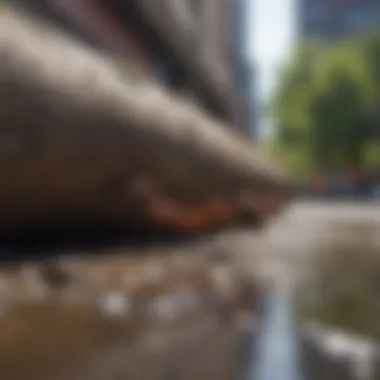

Ants hold a significant position in the food web, serving as both predator and prey. They help control populations of other insects by preying on them, thus indirectly protecting plants from potential damage caused by pests. For instance, when ants patrol their territories, they often hunt down small insects or gather materials from decomposing organic matter, contributing to the balance of local fauna.
Conversely, ants are also a food source for various species. Birds, reptiles, and even mammals rely on ants for nourishment. Particularly in urban settings, this can help maintain wildlife diversity, as various animals thrive off the abundance provided by ant populations.
"Ants are like the unsung heroes of our urban environments; they shape our surroundings without us even realizing it."
Recognizing ants' role in the food web can alter how homeowners approach pest control. Instead of viewing them solely as nuisances, it becomes clear that maintaining a balance with these insects can enhance garden health and contribute to the ecosystem.
In summary, ants significantly influence ecological health in every area they inhabit, even bustling cities like Seattle. Their social behavior, ecological interactions, and engineering skills not only sustain themselves but also support a diverse range of life forms, making them irreplaceable members of urban ecosystems.
Common Ant Species in Seattle
Understanding the various ant species that inhabit Seattle is crucial for homeowners and pest control professionals alike. Each species exhibits unique behaviors, habitats, and potential issues, making it important to identify them accurately. Knowing what type of ants you're dealing with can significantly influence management strategies and prevention tactics. By becoming familiar with these common pests, homeowners can take effective actions to mitigate their impact while also maintaining a healthy urban ecosystem.
Carpenter Ants
Identification
Carpenter ants are somewhat large, often measuring between half an inch to an inch in length. Their color ranges from black to a reddish hue, depending on the species. One distinct characteristic of these ants is their smooth, rounded thorax, which sets them apart from other ant species. Recognizing these features can help homeowners identify potential infestations early. Spotting a carpenter ant is beneficial for homeowners as it can lead to early detection of wood damage, thereby saving costs associated with repairs.
Habitat and Behavior
Carpenter ants thrive in moist, decaying wood, which is often found in older houses or areas with heavy vegetation. They excavate wood to create nests and are particularly active at night. This nocturnal behavior can make them harder to spot. Their preference for damp environments—like insulation, walls, or even tree stumps—indicates a potential structural hazard that homeowners need to monitor closely. This can be advantageous for property maintenance as it draws attention to underlying moisture-related issues that may arise.
Damage Potential
Carpenter ants can create significant damage over time, especially if not addressed promptly. Their tunneling activities compromise structural integrity, which can lead to costly repairs. Also, unlike termites, carpenter ants do not consume wood but rather hollow it out for nesting, causing concern for homeowners focused on maintaining property value. Thus, understanding their damage potential is crucial for developing effective monitoring and intervention strategies.
Pavement Ants
Identification
Pavement ants are smaller, typically around 1/8 inch long, and are dark brown to black in appearance. Their distinctive feature is the presence of two spines on their back, which is a quick identifying characteristic. Being able to spot these ants can help homeowners quickly identify colonies that may invade sidewalks or driveways, facilitating pest control measures.
Habitat and Behavior
They prefer to nest in the crevices of asphalt and under stones, which can lead to their proliferation in urban settings. Pavement ants are active during the day and are often seen foraging for food. Their adaptability to various environments is a significant point for homeowners to consider, as it can lead to invasions that encroach on living spaces. Their behavior, including food scavenging, can help in devising effective prevention tactics for keeping them at bay.
Impact on Property
While pavement ants don’t cause structural damage, they can be quite a nuisance. They often invade homes in search of food, which can lead to an unsightly and uncomfortable living situation. Their mere presence can trigger worries about hygiene that homeowners cannot overlook. Understanding their impact allows for better sanitation practices and proactive measures to deter them from entering property.
Sugar Ants
Identification
Sugar ants, typically small (around 1/4 inch), are known for their vibrant yellow to light brown color. Their love for sweets often leads them to invade homes, making identification easier when you start noticing tiny food trails in your kitchen. Recognizing these characteristics can greatly assist in managing their potential infestations.
Food Preferences
As their name indicates, sugar ants have a strong preference for sugary substances. They are often seen around sweet spills or food remnants, making it clear where their food sources lie. This behavior can highlight areas in the home that require more attention regarding cleanliness and food storage, encouraging better housekeeping practices among residents.
Nest Location
Sugar ants often build their nests in sandy soil or beneath shrubs. When they invade homes, it is usually in search of food. Understanding where they prefer to build nests can help homeowners in designing outdoor landscaping that discourages their presence close to foundations and entry points. This knowledge can be significant when creating a holistic approach to pest management in and around the home.
Ant Behavior and Nesting Patterns
Understanding the behavior and nesting patterns of ants in Seattle is crucial for several reasons. First, it can help homeowners identify if they have an infestation, leading to quicker and more effective management. Also, knowing about their nesting habits aids in preventive measures, allowing residents to create environments that discourage ant colonization. Furthermore, grasping the social structure of ant colonies sheds light on their interactions and how they function as a group, unveiling insights that can inform control methods.
Social Structure of Ant Colonies
Queens, Workers, and Drones
The social structure within an ant colony is intricate. At the top of the hierarchy sits the queen, whose primary function is reproduction. A key characteristic of the queen is her ability to lay thousands of eggs, ensuring the colony's growth and sustainability. This detail is vital, as it emphasizes the queen's role in the harmonic functioning of the colony. Conversely, worker ants do various tasks, from foraging for food to caring for the young. Their adaptability makes them beneficial players in the colony's everyday operations.
Drones, the male ants, have a singular role during mating season, adding a layer of complexity to the colony's dynamics. The unique feature of the drone is that once they mate with a queen, they usually die shortly after, which indicates the harsh realities of ant survival.
"The efficiency of each caste in the ant community illustrates not just survival tactics, but a meticulous choreography of life."
This division of labor is advantageous as it allows the colony to operate smoothly, fostering specialization that enhances survival. However, if environmental changes disrupt this structure, it can lead to significant issues for the colony.
Colony Dynamics
Colony dynamics cover how ant communities interact, establish hierarchies, and manage resources. A key aspect here is communication. Ants utilize pheromones to relay information about food sources and threats, making their communication effective and vital for survival. This unique feature of chemical signaling facilitates their collective efforts in foraging and defending their nest.
The dynamics within a colony can adapt based on environmental factors. For instance, during resource shortages, colonies might show increased aggression towards neighboring nests or increase foraging duration.
Although the flexibility of colony dynamics is generally beneficial, it can lead to conflicts with other colonies or even disrupt local ecosystems, raising concerns for homeowners experiencing infestations.
Nesting Sites in Urban Areas
Common Nest Locations
In urban settings like Seattle, ants can establish nests in various locations. Some typical spots include beneath rocks, inside walls, or even within decaying wood. This adaptability is crucial, as it allows them to take advantage of resources in an urban environment.
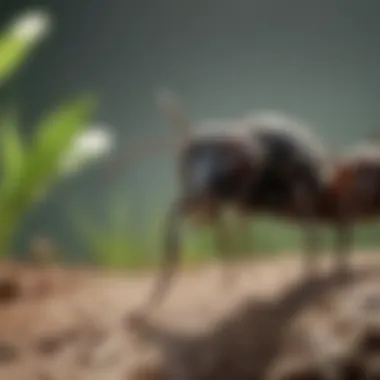
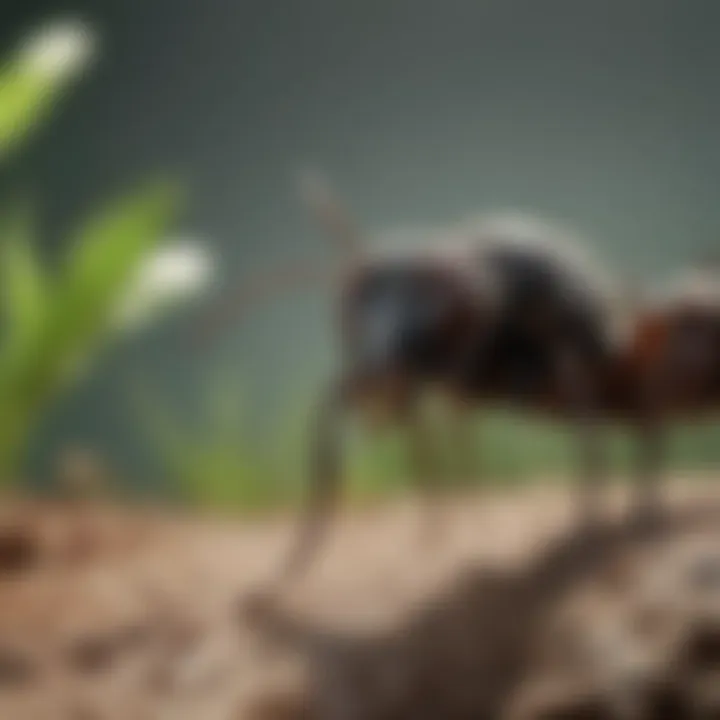
Homeowners need to understand these common nesting sites to prevent infestations. Identifying potential nesting areas can save significant time and reduce the chances of a larger infestation developing, benefitting the overall home environment. For example, carpenter ants tend to dig into wooden structures, creating hollow pathways that severely compromise the strength of wood over time.
Seasonal Nesting Patterns
Ants exhibit behavioral changes based on seasons, with nesting patterns being especially affected. During warmer months, ants can be more active, leading to a higher risk of infestations. As seasons shift, they may move their nests closer to human structures to escape colder conditions. Understanding these patterns aids homeowners by aligning preventative measures with seasonal changes.
For instance, in the spring, when ant activity peaks, proactive measures such as sealing cracks and reducing food availability can effectively deter them. However, in the fall, while preparing for winter, ants often shift focus to resource accumulation, increasing the likelihood of them invading homes.
Implementing awareness of these seasonal nesting habits into home maintenance can significantly decrease the chances of encountering trouble with these pesky insects.
By delving into ant behavior and nesting patterns, Seattle residents can better equip themselves against potential infestations, fostering a proactive approach to home maintenance.
Identifying Ant Infestations
Identifying ant infestations is crucial for homeowners in Seattle, as it allows them to take appropriate measures to address potential problems before they escalate. Ants might be tiny creatures, but their colonies can grow in numbers swiftly, turning what seems like a minor blip into a significant headache. The sooner you pinpoint their presence, the easier it is to tackle the issue head-on.
Signs of Ant Presence
Spotting ants scurrying around your property is often the most obvious sign of an infestation. However, this isn't the only thing to look for. Here are some telltale signs that ants may have set up shop in your home:
- Ant Trails: These are usually the first clear indicators of an infestation. Ants often follow the same path to food sources, creating visible trails.
- Nests: Look under potted plants, along the foundation, or in cracks and crevices for nests. Carpenter ants, for example, can hollow out wood and create nests inside.
- Food Baits: If you’ve noticed uneaten food items disappearing or showing signs of nibbling, ants may be the culprits. Sugar ants are particularly notorious for raiding kitchens.
- Sawdust: Especially with carpenter ants, finding sawdust near wooden structures can signal nesting activity.
- Colony Size: If you notice a sudden increase in the number of ants, this can indicate a growing colony and a more serious issue.
"Early detection is half the battle in managing ant infestations effectively."
Why Quick Identification Matters
Thinking of ants as just another minor nuisance could prove problematic. Here are key reasons why recognizing an infestation early is vital:
- Prevention of Structural Damage: Carpenter ants and similar species can cause significant damage to wooden structures. Quick identification allows for timely intervention to prevent costly repairs.
- Health Considerations: Ants can infest kitchens and pantries where food is stored, posing health risks for families. Some species may carry bacteria harmful to humans, so it’s better to act fast.
- Effective Control: The more quickly you determine which type of ant is present, the more effectively you can apply tailored control measures. Not all ants respond the same way to various treatments, so knowing your enemy is essential.
Documenting Your Findings
When you suspect an infestation, taking notes helps track the situation. Keep a record of:
- Locations where you see ants most frequently.
- The type of ant, if identifiable.
- Trends in activities, like time of day or specific food sources they seem to favor.
Steps to Take After Detection
Once you've got a handle on the situation, consider implementing the following:
- Seal Entry Points: Make sure no additional ants can come in. Close gaps around windows and doors, and check utility cables.
- Clean Thoroughly: Erase their scent trails by cleaning regularly. This deters ants from returning. Pay close attention to food storage areas.
- Choose Control Methods: Decide if you want to use natural solutions, like essential oils, or opt for chemical treatments that target specific species.
Dealing with ant infestations can be daunting, but identifying their presence is the first step to regaining control of your home. With the right knowledge and actions, you can turn the tide in this tiny battle against these industrious pests.
Impact of Ants on Homes and Health
Understanding the impact of ants on homes and health is crucial for Seattle homeowners, especially given the interactions people have with these small yet significant creatures. Ants are often dismissed as a mere nuisance, but their presence in domestic spaces can lead to a variety of unforeseen consequences.
On the one hand, ants play vital roles in the ecosystem, aiding in soil aeration and seed dispersion. However, when they invade homes, notably during spring and summer months, they can swiftly transition from beneficial species to unwelcome guests that threaten structural integrity and potentially human health. It's important to recognize these challenges, as they can influence both the livability of a home and the wellbeing of its inhabitants.
When we discuss structural damage, we uncover the significant ways ants can undermine the very foundations of our homes. On another front, understanding the health risks associated with ants sharpens our awareness of how these invaders might affect our families.
Structural Damage
Ants can cause structural damage, especially the carpenter ant species, which are notorious for their wood-destroying habits. Unlike termites, carpenter ants don't eat wood; instead, they excavate it to create their nests. This can lead to significant and expensive damage if left unchecked.
- Signs of Carpenter Ant Damage:
- Hollow sounds when knocking on affected wood.
- Frass (discarded wood shavings) near nests or damaged areas.
- Visible trails leading to their nests or food sources.
The damage can weaken beams, posts, and walls, leading to costly repairs. A small infestation may grow over time into a much larger problem, potentially requiring structural repairs worth thousands of dollars.
The bottom line? Homeowners should prioritize checking for these signs and act swiftly when they suspect an infestation.
Health Risks Associated with Ants
In addition to structural concerns, it’s also critical to think about the health implications sewage of ant infestations. While ants are not typically carriers of dangerous diseases, some species can pose health risks that should not be ignored.
- Potential Health Risks Include:
- Contamination of food sources. Ants often forage for sugary substances and can inadvertently carry bacteria from garbage or decaying organic material.
- Allergic reactions. Some people may experience allergic responses to ant bites or stings, particularly from fire ants, which can lead to severe reactions in sensitive individuals.
Remember: Keeping food sealed and cleaning promptly can help mitigate these risks, minimizing the likelihood of inviting ants into your living space.
By understanding the structural and health impacts ants can have in Seattle homes, property owners can take proactive measures to safeguard their dwellings and the wellbeing of their family members. Awareness is key in preventing what could become a more significant issue down the line.
Prevention Strategies for Homeowners
When it comes to battling ant infestations, prevention is the name of the game. Understanding and implementing effective strategies can save you a world of hassle down the line. In Seattle, where moist conditions often give rise to unwanted critters, being proactive is especially key. Not only does proper prevention minimize the chances of an ant invasion, but it also bolsters the overall health and cleanliness of your home.
Sanitation Practices
Keeping your living space clean is one of the most immediate steps you can take in preventing ant colonies from setting up shop. Even the smallest morsels of food can be an irresistible invitation for these pests. Heavy-duty cleaning should become part of your routine. Here are some effective sanitation practices:
- Store Food Properly: Make sure to use airtight containers for all your food items. This not only helps to keep food fresh but also minimizes odors that attract ants.
- Clean Up Crumbs: After every meal, wipe down surfaces thoroughly and vacuum floors to eliminate any crumbs or spills.
- Handle Pet Food: Ensure that pet bowls are cleaned up promptly and that their food is stored securely to prevent attracting ants.
- Empty Trash Regularly: Keep garbage cans sealed and dispose of waste frequently. A smelly trash can is like an open buffet to ants.
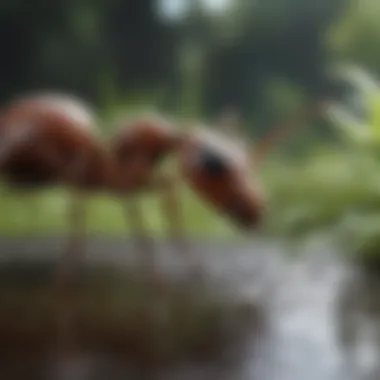
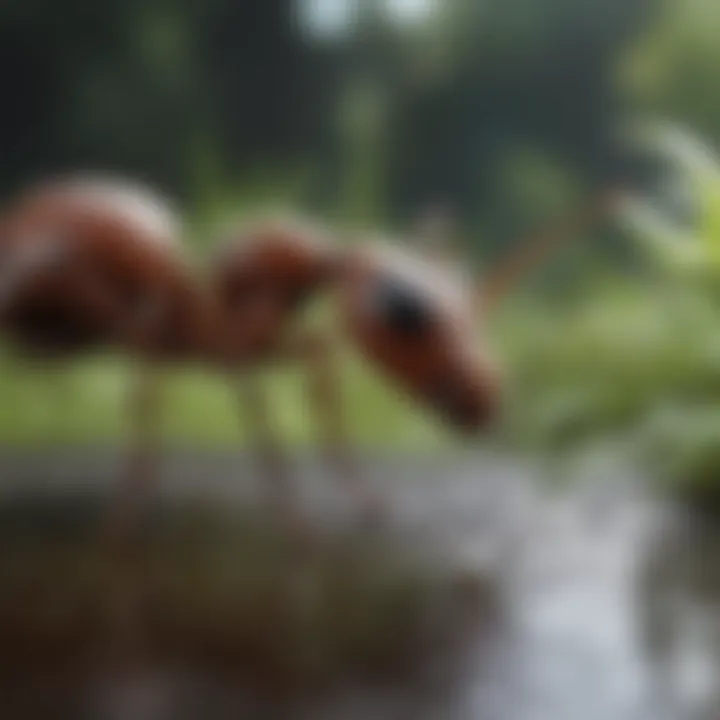
These practices not only deter ants but also make your home a healthier place.
Sealing Entry Points
Once you’ve got the sanitation practices down, the next frontier is to seal off any potential access points for ants. You've heard the saying, "A chain is only as strong as its weakest link"—well, your home is no different. Even tiny cracks and crevices can provide unwelcome entries. Here’s how you can fortify your home:
- Inspect Foundations and Walls: Check for cracks in your home’s foundation or gaps in walls. Seal these with caulk or other appropriate materials.
- Cover Entrances: Doors and windows should be fitted with screens, and thresholds should be watertight. This prevents not only ants but other pests as well.
- Check Utility Lines: Pipes or electrical wires that enter your home can be easy access points. Make sure these are snug against the wall and sealed if necessary.
By bolstering your defenses and sealing up any potential breaches, you make it that much harder for ants to breach your walls.
"Prevention is better than cure."
Control Methods for Ant Infestations
Managing an ant infestation is crucial not only for your peace of mind but also for protecting your property. Ants, while generally harmless, can cause significant structural damages, particularly species like Carpenter ants. Furthermore, their presence often suggests poor sanitation conditions that can breed health issues, creating a pressing need for effective control methods. This section will explore various means of addressing ant infestations, balancing both natural and chemical approaches to find a sustainable solution that fits different household needs.
Natural Control Methods
Natural methods often appeal to homeowners looking for eco-friendly alternatives to chemical pesticides. They can be less harmful to the environment and safer for pets and children.
Essential Oils
Essential oils are becoming increasingly popular as a natural deterrent for ants due to their potent aroma and properties. Oils such as peppermint, tea tree, and eucalyptus are highly regarded for their insect-repelling capabilities.
The key characteristic of essential oils is their ability to disrupt the ant's pheromone trails, which are crucial for their navigation and communication. By masking these chemical signals, essential oils can make it more challenging for ants to locate food sources and their nests.
One unique aspect of essential oils is their versatility. They can be used in various ways: diluted in water as a spray or soaked in cotton balls placed around entry points. However, it��’s worth noting that while they may reduce ant activity, they rarely eliminate entire colonies, meaning they are best used as a preventative measure rather than a sole solution.
Homemade Solutions
Homemade solutions are another widely embraced approach, combining practicality with cost-effective methods. Ingredients often include vinegar, borax, or soap, all of which can disrupt an ant's life cycle.
A notable feature of homemade solutions is their accessibility. Most households have these ingredients readily available, making it easy to whip up a quick remedy when ants make their unwelcome appearance. For instance, a mixture of vinegar and water can serve both as a cleaner to remove ants’ scent trails and as a repellent.
The downside, though, is that while homemade remedies can provide temporary relief, they may not tackle severe infestations. Homeowners need to keep this in mind; sometimes, a stronger approach is needed if ant populations continue to thrive despite the use of these solutions.
Chemical Treatments
Chemical treatments can be necessary when natural methods fail to deter persistent infestations. Though these options often raise concerns regarding risks to health and the environment, they can be effective in tackling significant ant problems.
Baits and Insecticides
Ant baits and insecticides function by attracting ants and delivering a lethal dose if they consume the bait. The primary benefit of baits is that they allow for targeted treatment. Unlike traditional insecticides that kill on contact, baits infest the colony since worker ants bring the toxic substance back to share with others, including the queen.
This characteristic makes baits particularly effective in addressing larger colonies that are harder to reach. However, the unique feature of this method is that it can take some time to see results, as the entire colony needs to consume the bait. One downside is the potential negative effects on non-target species; hence, careful placement is essential to minimize risks.
Professional Pest Control Options
When infestations spiral out of control, professional pest control can be the best route for homeowners. Trained experts have access to specialized tools and methods that are typically more effective against deeply entrenched ant colonies.
A key aspect of professional pest control is their tailored approach. They conduct thorough inspections to assess the situation and strategize on an effective treatment plan. This personalized management ensures that particular species of ants and their behaviors are addressed with suitable solutions.
The significant advantage of this method is the post-treatment support that professionals provide—advice on prevention strategies can help reduce the chance of an infestation recurring. However, the downside is the associated costs and the potential dependency on external help, which might not appeal to all homeowners.
By understanding these various control methods, whether natural or chemical, homeowners in Seattle can tailor their approach to effectively manage ant infestations without compromising their living spaces.
When to Seek Professional Help
Dealing with ants in your home can often feel like a never-ending battle, especially here in Seattle where they seem to pop up everywhere. Knowing when to call in the pros is vital. It can save you time, money, and unnecessary frustration. This section delves into the elements that signal the need for professional intervention, balancing out the homeowner's DIY efforts with expert assistance.
Identifying the Severity of the Infestation
First off, it’s essential to correctly assess the extent of the ant problem. If you’ve noticed a handful of ants scuttling across your kitchen counter, it might be tempting to dismiss it. However, it could be indicative of an intricate network of nests within or around your home. In Seattle, ant colonies can grow rapidly due to their social structure, making it tough to tackle the issue single-handedly.
- If you see ants consistently marching in and out, especially if they are carrying food or materials, it’s time to get real.
- Infestations that persist despite your efforts indicate that these little invaders are well-established.
"Ants are like an uninvited guest; once they start making themselves at home, it gets harder to show them the door."
The Type of Ants Matters
In this bustling urban environment, the species of ants can greatly influence the need for professional help. Some ants, like sugar ants, may be less destructive but can be quite a nuisance, while others, like carpenter ants, pose a genuine threat to your property. Identifying the type of ant can guide you in your decision-making. If you identify species that are known to cause structural damage, such as carpenter ants, it's often prudent to consult a pest control expert early on.
Health Concerns
Another significant factor to consider is the health risks associated with certain ant species. Some may carry bacteria or contaminate food, posing unsanitary conditions in your home. If you have young children or pets, this alone warrants seeking help from professionals who can provide targeted solutions without risking your family's health.
- Chemical treatments—for example, those used in ant baits—should be handled with care. It’s often best left to those who know what they’re doing. Professionals can apply these treatments safely and effectively, minimizing risks.
Specialized Tools and Techniques
Pest control professionals are equipped with specialized tools and methods to handle infestations that homeowners typically don’t possess. They often employ advanced techniques and eco-friendly pest control options tailored for Seattle. These methods ensure that not only are the ants eliminated, but your living environment remains intact and safe for family and pets.
Long-Term Solutions
Lastly, consider the long-term perspective. Even if you successfully rid yourself of an ant invasion, it doesn't guarantee that they won't return. Professionals can inspect your home thoroughly, identify underlying issues, and provide strategies to prevent future infestations. It's an investment in your peace of mind.
Epilogue
In wrapping up our exploration of ants in Seattle, it's vital to reflect on the significance of understanding these small yet impactful creatures. Ants are more than just a nuisance; they play essential roles in our ecosystem, influencing soil health and even serving as prey for various wildlife. Their presence in urban settings like Seattle prompts a need for homeowners to grasp not only their behaviors but also the local species that may invade homes.
By recognizing the types of ants present in the region—such as Carpenter ants, Pavement ants, and Sugar ants—homeowners can identify potential problems before they escalate. For instance, Carpenter ants do not just meander through your space; they can cause considerable structural damage if left uncontrolled.
Moreover, understanding the nesting patterns of these ants can provide insights into their behavior in urban areas. From sidewalk cracks to loose wood, knowing where ants prefer to build their homes allows for better prevention and control strategies.
"Knowledge is power, especially when it comes to pest management."
In this article, we delved into various prevention tips, emphasizing cleanliness and sealing entry points. Effective control methods, both natural and chemical, offer numerous options tailored to different preferences and situations. Homeowners equipped with this knowledge can maintain a healthier home environment, reducing the risk posed by these pests while preserving the delicate balance of our ecosystems.
Ultimately, taking action at the right time is critical. Knowing when to pursue professional assistance ensures that ant infestations are managed promptly and effectively, saving homeowners from headaches down the road. With a clear understanding and practical strategies, individuals can confidently protect their homes from ants while appreciating their ecological niche in Seattle.
As the old saying goes, "An ounce of prevention is worth a pound of cure." By taking proactive measures against these tiny invaders, homeowners can enjoy their living spaces without the worry of ant-related issues.



